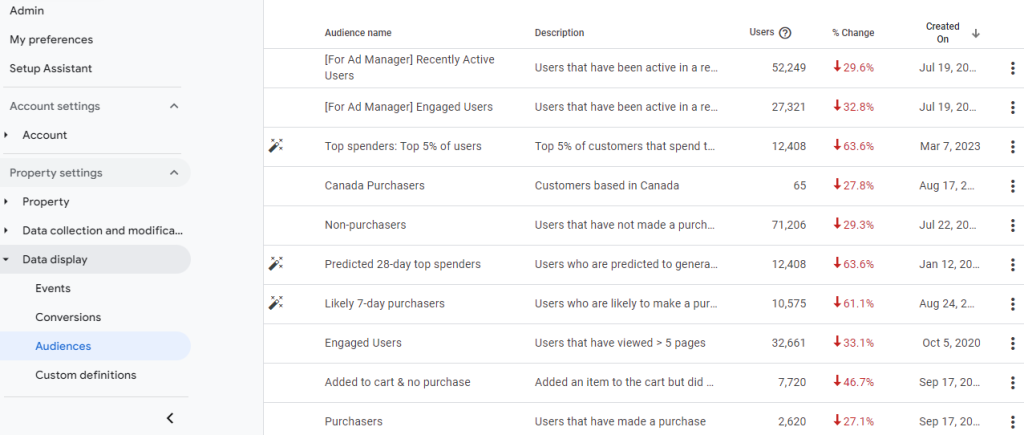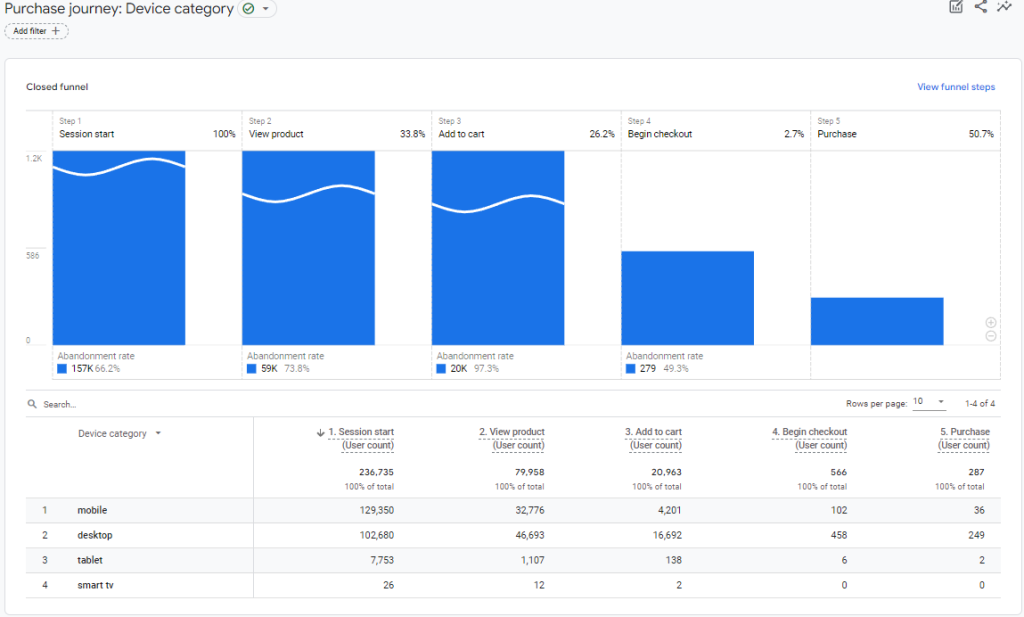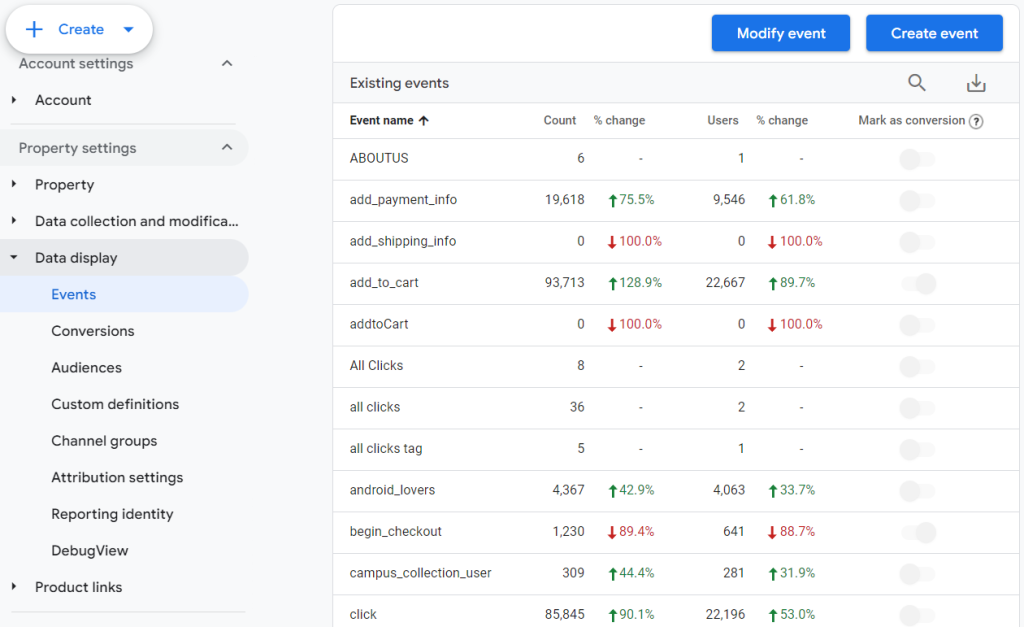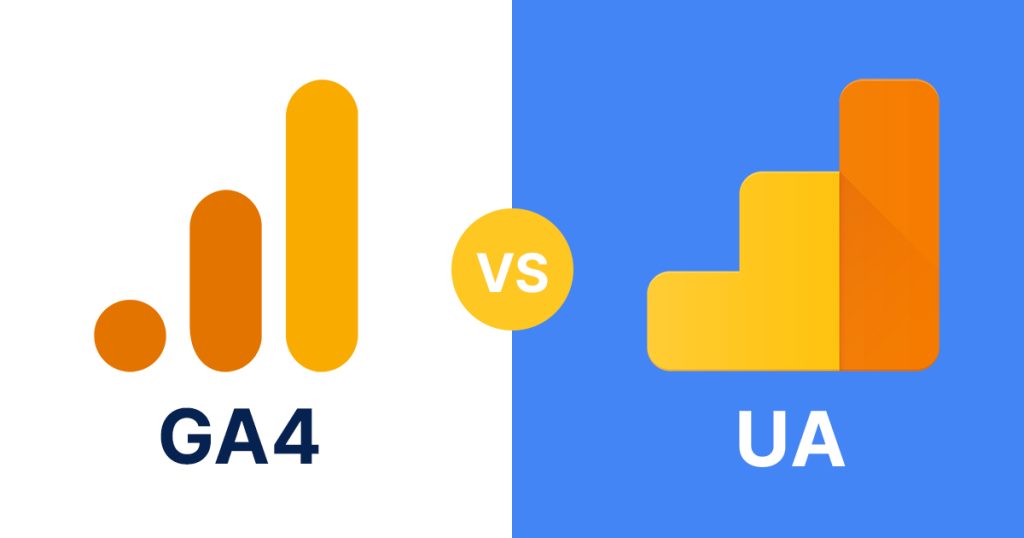If you’re running a business, you probably know that understanding your website’s traffic and how people interact with it is super important. Google Analytics has been the go-to tool for this for years.
But now, there’s a new version called Google Analytics 4 (GA4), and it’s got a lot of people talking. You might be wondering, “Is GA4 better than the older Universal Analytics?”.
Don’t worry, we’ve got you covered. In this blog, we’ll look at what’s different between the two and what you should watch out for.
Feeling overwhelmed by analytics? Let us, Goodish Agency, simplify your GA4 migration. Learn about our services and contact us for expert help.
Table of Contents
1. Data Collection Methodology
2. User Privacy Features
3. Audience Building and Targeting
4. Cross-Platform Tracking
5. Predictive Metrics
6. Audience Building
7. E-commerce Tracking
8. Event Tracking
9. Data Retention
10. Reporting Dashboards
11. User Identification
12. Cost and Pricing
13. Integration and Compatibility
14. Learning Curve and Usability
15. Conclusion
Data Collection Methodology
Universal Analytics: Session-Based
In Universal Analytics, data collection revolved around “sessions.” A session begins when a user lands on your website and ends when they exit. Within this timeframe, Universal Analytics tracked various activities like:
– Pages visited
– Time spent on the site
– User interactions
This approach gives you a broad overview of a visitor’s journey, almost like watching a short film of their time on your site.
GA4: Event-Based
Contrastingly, GA4 employs an “event-based” methodology. Instead of capturing the entire visit, GA4 focuses on individual actions, termed as “events“, such as:
– Clicking a button
– Filling out a form
– Scrolling down a page
Each action is recorded separately, giving you a detailed view of user behavior, much like a detailed photo album of each interaction.
What It Means for You
The shift from a session-based to an event-based model impacts how you interpret user interactions:
Universal Analytics: Provided a holistic view, suitable for general insights.
GA4: Offers detailed action points, ideal for in-depth analysis.
User Privacy Features
When it comes to respecting user privacy and following the law, GA4 is the go-to option. It comes with built-in settings that help you manage user data in compliance with privacy laws like the GDPR in Europe and the CCPA in California. This is crucial because failing to adhere to these laws can result in penalties.
Universal Analytics didn’t offer as many privacy-friendly features. If you were using it before the transition, you might have had to put in extra effort to ensure you were handling people’s personal information correctly. This could have meant more work for you to stay compliant.
With the mandatory shift to GA4, the platform aims to make it easier for you to follow privacy laws. It’s designed with user privacy in mind, reducing the burden on you to take additional steps for compliance.
Audience Building and Targeting
Universal Analytics: Limited Customization
In the past, Universal Analytics gave you some options for grouping your website visitors into different categories, known as “audiences.”
You could sort people based on things like their age, what kind of device they were using, or how they behaved on your site. However, these options were pretty set in stone. You had a list of choices, but you couldn’t mix and match them in many creative ways.
GA4: A New Level of Flexibility
GA4 changes the game when it comes to building audiences. It lets you get really specific about who you want to target. You’re not just limited to basic categories like age or location. With GA4, you can combine all sorts of information to create an audience that’s tailored just for your business.

For example, you can target people who visited a particular page on your site and also filled out a contact form. This means you can send messages or ads that are likely to be more interesting to those specific people, making your marketing efforts more effective.
Why It Matters
The way you build audiences can make a big difference in how successful your marketing campaigns are. With Universal Analytics, you might have felt a bit restricted.
But GA4 gives you the tools to carve out your own unique shape. You can get as detailed as you want, allowing you to reach the right people with the right message at the right time.
Cross-Platform Tracking
Universal Analytics
With Universal Analytics, tracking users across different platforms like your website and mobile app was possible, but it required additional setup and configuration. It wasn’t straightforward and could be time-consuming.
GA4: Built for Today’s World
GA4, on the other hand, is made for today’s interconnected world. It’s like having a super-smart system that can follow your customers wherever they go, whether they’re browsing your website on a laptop, using your mobile app, or even interacting with your business in the real world, like at a physical store.
GA4 ties all these interactions together, giving you a complete picture of what your customers are doing and what they’re interested in.
Why This Matters
Understanding your customers is key to any successful business. In the past, you might have only seen part of the picture. Maybe you knew what people did on your website but had no idea about their behavior on your app. GA4 solves this problem by bringing all the pieces together. You get to understand the full story of your customer’s journey, from start to finish.
This complete view helps you make better decisions. You can see which marketing strategies are working across all platforms and which ones need tweaking. It’s a powerful tool for any business looking to understand their customers better and improve their marketing efforts.
Predictive Metrics
Universal Analytics: Lacking Native Features
In Universal Analytics, if you wanted to predict future trends or customer behaviors, you were mostly on your own. You had to use other tools outside of Universal Analytics or set up custom configurations. This could be tricky and often needed some technical skills.
GA4: A Step Ahead
GA4 makes your life easier by offering predictive metrics right within the platform. This means GA4 can look at past data and use it to make educated guesses about what might happen next.
For example, it can predict which products are likely to become best-sellers or what kind of content your audience will engage with next. This is incredibly useful for businesses, especially when planning marketing campaigns or deciding where to allocate resources.
The Advantage for You
Having predictive metrics built into GA4 can save you time and effort, allowing you to focus on making data-driven decisions more efficiently. It eliminates the need for third-party tools or complicated setups, making it easier for you to plan for the future.
Audience Building
In Universal Analytics, creating audiences is a bit limited. You can sort people based on things like age, where they live, or what device they’re using, but that’s about it. It’s a bit like putting people into basic categories, which doesn’t give you a lot of room to get specific.
On the other hand, GA4 lets you get really detailed when you’re building audiences. You can use all sorts of information, like what actions people are taking on your site right now or what they’ve done in the past.
This means you can target your marketing more precisely to different groups of people. For example, you could create an audience of people who have looked at a product but haven’t bought it yet, and then send them a special offer.
If you’re looking to get really specific with your marketing, GA4 gives you the tools to do it. It’s a more flexible and dynamic way to understand and reach out to your audience.
E-commerce Tracking
When it comes to e-commerce tracking, both Universal Analytics and GA4 have their own ways of helping you understand your online business.
Universal Analytics offered a straightforward setup for tracking your online sales. It provided essential information like which products are viewed the most, what items are added to the cart, and what purchases are made. It was relatively easy to get started with, but the features were limited to basic tracking.
On the other hand, GA4 offers a more advanced and customizable tracking system. It allows you to understand customer behavior in greater detail. For example, you can track how many times a customer viewed a product before making a purchase or how a promotional campaign is affecting your sales.

However, these advanced features may require additional setup and configuration, making it a bit more time-consuming to get started.
Event Tracking
In the past, event tracking with Universal Analytics often required you to add extra code to your website. This could be a technical and time-consuming process, especially if you wanted to track custom events like button clicks or form submissions.
Fast forward to GA4, and the landscape has changed dramatically. Now, you can easily set up and track custom events directly from the dashboard, no additional coding required. This is a big deal because it makes the process much simpler.
GA4’s approach to event tracking is more user-friendly and flexible. It allows you to focus on the metrics that are most important to you without the without the extra work of setting up code. So, whether you’re interested in tracking basic interactions like page views or more complex actions like e-commerce transactions, GA4 makes it simple.

Data Retention
In the past, Universal Analytics had set rules for how long it would keep your data. You couldn’t change these settings, so you had to work with what you got. This could be limiting if you needed to keep data for a longer or shorter period for your specific needs.
On the other hand, GA4 gives you more control over your data. You can choose how long you want to keep information, making it easier to follow privacy laws or business policies. This flexibility is a big plus, especially if you have unique data storage needs for your business.

Reporting Dashboards
Universal Analytics gave you a set of pre-made dashboards to look at your data. These dashboards were helpful but didn’t offer much room for change. You got what you got, and if you needed to see your data in a different way, you were out of luck.
GA4, however, takes this to a whole new level. It lets you build your own dashboards from scratch. This means you can choose exactly what data you want to see and how you want to see it. You can make it as simple or as detailed as you like.
This is great for businesses that have specific questions about their website or customer behavior, as you can change the dashboard to answer those questions directly.

User Identification
Universal Analytics mainly used small pieces of data called cookies to figure out who was visiting your website. These cookies would store some information about the user, like how many times they’ve visited your site or what pages they looked at. While this was useful, it had its limits. For example, if someone cleared their cookies or used a different device, Universal Analytics might not recognize them as the same user.
GA4 takes a different approach. It still uses cookies, but it also uses other ways to identify users. This could include things like device IDs or user accounts if someone is logged in. This gives you a more complete picture of who your users are.
This is especially useful in today’s world where people often switch between different devices like phones, tablets, and computers. GA4’s approach makes it easier to understand how a single user interacts with your site across different platforms. This can help you make your marketing strategies more effective, knowing you have a more accurate view of your audience.
Cost and Pricing
Universal Analytics offered a generally free service that met the needs of many businesses. For those requiring more extensive capabilities, there was a premium option. Now, with GA4 as the standard, it’s important to understand its pricing structure.
GA4 also provides a free version, which includes a wide range of features suitable for small to medium-sized businesses. However, if you’re looking for more advanced functionalities, especially in the areas of machine learning and predictive analytics, you might need to go for a premium subscription.
The premium version unlocks a lot of advanced features that can offer deeper insights and more effective data analysis. This is particularly beneficial for larger enterprises or businesses with specific needs that go beyond the capabilities of the free version.
However, the cost of a premium subscription could be a significant factor for small businesses or startups operating on a tight budget. Therefore, it’s crucial to evaluate whether the additional features will provide enough value to justify the extra expense.
Integration and Compatibility
Universal Analytics had built a reputation for easily integrating with a variety of Google services as well as third-party platforms. This made it a versatile tool for businesses that used multiple services to manage their online presence. GA4 takes this a step further by offering even smoother integrations, particularly with Google’s suite of advertising platforms like Google Ads.
With GA4, linking your analytics data to your advertising campaigns becomes a easier. This is a big deal because it’s easier to connect your analytics and ads, helping you create a single, effective marketing plan. You can easily see how your ads are performing and how users are interacting with your website or app, all in one place.
This not only saves you time but also provides more accurate and comprehensive data that you can use to optimize your advertising efforts. In short, the enhanced integration features in GA4 make it easier than ever to connect the dots between your analytics and advertising, helping you make smarter decisions.
Learning Curve and Usability
If you’ve used Universal Analytics before, you know it was fairly easy to get started, but there was still a bit to learn to really get the most out of it. GA4 is no different in that it also has a learning curve, especially with its new features and ways of collecting data.
However, once you get past the initial learning phase, GA4 offers a more user-friendly experience. It’s especially easier to navigate for those who are already using other Google products.
Conclusion
Google Analytics has long been the industry standard for understanding customer behavior and website performance. With the introduction of Google Analytics 4 (GA4), the game has changed, offering more advanced features, better user privacy controls, and a more flexible approach to data collection and analysis.
From the way you collect data to how you build audiences for targeted marketing, GA4 offers a range of new capabilities that can help you gain deeper insights into your customer behavior.
But like any new tool, GA4 comes with its own set of challenges, especially if you’re transitioning from Universal Analytics. The good news is, you don’t have to go it alone. At Goodish Agency, we specialize in GA4 and can help guide you through the migration process.
Whether you’re a small business owner looking for basic analytics or a large enterprise in need of comprehensive data analysis, GA4 has something to offer. It’s not just about keeping up with the times; it’s about staying ahead of them.
We at Goodish agency are experts in digital marketing and we can help you to utilize AI to reduce your costs and boost your performance. Read more about our services.











